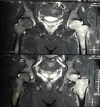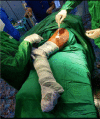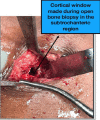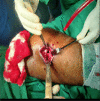A Rare Case of Burkholderia Osteomyelitis Affecting the Hip Joint in an Adult
- PMID: 37056604
- PMCID: PMC10088376
- DOI: 10.13107/jocr.2022.v12.i12.3472
A Rare Case of Burkholderia Osteomyelitis Affecting the Hip Joint in an Adult
Abstract
Introduction: Burkholderia pseudomallei is a gram-negative bacillus. It is predominant in Southeast Asia and Australia. Melioidosis of the hip joint is a very rare condition. This case report is to the best of our knowledge, the only study showcasing an acute proximal femoral osteomyelitis of the hip joint caused by Burkholderia pseudomallei.
Case report: A 47-year-old male, a known case of diabetes mellitus since 7 years, presented with fever for 2 weeks and pain over left hip for 10 days. He gave a history of treatment for typhoid fever with multiple intravenous and intramuscular injections, 1 month before his present symptoms. On Examination: His left hip joint was tender and all movements of the hip were restricted. His blood investigations revealed high counts (TC=10,150), erythrocyte sedimentation rate (116), and a positive C-reactive protein (CRP). X-ray of the hip joint was normal. An magnetic resonance imaging (MRI) of the hip joint showed bone marrow edema and infiltrates of the left proximal femur, suggestive of an osteomyelitis. The patient was treated with an initial open bone biopsy and culture, which was reported as no growth. Due to persistent surgical site infection, a repeat pus culture and sensitivity yielded growth of Burkholderia pseudomallei. Hence, a wound debridement, bone curettage, and antibiotic cement bead application (Using vancomycin and tobramycin) was done. The wound healed well, and the CRP values and counts dropped rapidly to become normal. Oral cotrimoxazole was started as per the eradication regime. The cement beads were removed after 2 months. A repeat MRI done after 1 month showed that the collection in the left femur was resolving. The patient was treated with injection ceftazidime (1 g Iv Bd X 3 weeks) and was advised to continue oral cotrimoxazole for a total of 6 months.
Conclusion: Isolated bone infection caused by Burkholderia pseudomallei is probably underreported in India. It has a variable presentation and closely mimics tuberculosis. Its early diagnosis, early aggressive surgical treatment, and prolonged antibiotic administration are vital to prevent the chronicity of this infection and decrease the morbidity.
Keywords: Burkholderia osteomyelitis; Burkholderia pseudomallei; Melioidosis; osteomyelitis.
Copyright: © Indian Orthopaedic Research Group.
Conflict of interest statement
Conflict of Interest: Nil
Figures









References
-
- Yee KC, Lee MK, Chua CT, Puthucheary SD. Melioidosis, the great mimicker:A report of 10 cases from Malaysia. J Trop Med Hyg. 1988;91:249–54. - PubMed
-
- Iyengar R, Manikanta MD, Goveen M. Chronic osteomyelitis of the femur caused by Burkholderia pseudomallei in a patient with Type 2 diabetes mellitus. J Clin Sci Res. 2021;10:43–6.
-
- Kosuwon W, Taimglang T, Sirichativapee W, Jeeravipoolvarn P. Melioidotic septic arthritis and its risk factors. J Bone Joint Surg Am. 2003;85:1058–61. - PubMed
Publication types
LinkOut - more resources
Full Text Sources
Research Materials
Miscellaneous
